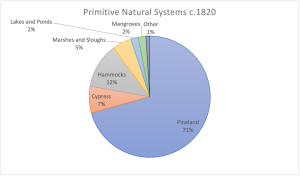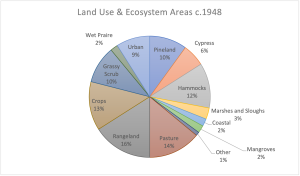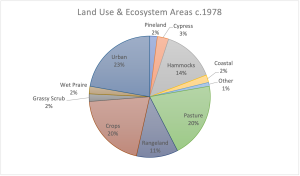The following is paraphrased from a 1979 study conducted by the University of Florida for Hillsborough County Government
This historical look at the predominant plant communities of Hillsborough County’s past was divided into five periods or eras: primitive (2000 b.c.-1820); territorial (1821-1879); railroad (1880-1900); boom & bust (1901-1948); and present (1949-1979).
The county is characterized by relatively flat terrain and low elevations. There are four major natural regions in the county: highlands of sandhills, inland flatwoods, coastal lowlands, and river valleys.
Primitive Era c. 2000 B.C.-1820
From table #1, it can be seen that a majority of the county was covered with pine forests (70%). Other dominant ecosystems were those associated with wetlands in the form of hydric hammocks (12%) and cypress domes and strands (7%).
Table #1 – 1820
| System Type | Acres | Land Area | |
|
Pine System |
459906.45 | 70.38 | |
| Hardwood Hammocks | 1437.61 | 0.22 | |
| Lakes and Ponds | 12807.85 | 1.96 | |
| Wet Prairie | 1045.53 | 0. I 6 | |
| Cypress Domes and Strands | 46918.56 | 7.18 | |
| Hydric Domes | 77761.96 | 11.90 | |
| Marshes and Sloughs | 33130.51 | 5.07 | |
| Salt Marsh | 653.46 | 0. l 0 | |
| Mangroves | 5358.38 | 0.82 | |
Boom and Bust Era 1901-1948
The percent distribution of land use types for 1948 is shown in figure 2.10. When comparing the land uses of 1948 to those of the Primitive Era, dramatic changes can be seen. Pine forests, which were formerly the most dominant ecosystem, occupy only 10% of the county. Most of this pineland was converted to agricultural (44%) and urban (9%) uses.
Present Era 1949 – 1979
Figure 2.13, shows the increasing trend toward urbanization. Over the thirty-year period from 1948 to 1978, the amount of urban land increased by 13% and the agricultural land area increased by 8%. The growth of the urban and agricultural sectors have been at the cost of the natural system. Pine forests which once occupied 70% of the county now occupy only 2% of the same area. With the easily developable pineland being depleted, urban and agricultural development has begun encroaching more heavily on the fragile wetland and coastal areas.
NATURAL SYSTEMS CLASSIFICATIONS
GRASSY SCRUB SYSTEM
Also known as dry prairie and native rangeland. It is a treeless system dominated by grasses and shrubs, occurring in seldom-flooded, dry areas having frequent fires. Dominant species are saw palmetto and wire grasses. Soil and drainage characteristics are similar to those of pine flatwoods, but the increased frequency of fire prevents the growth of pines. The activities of main in harvesting pine trees, in draining, and increasing the frequency of fire have converted many former pineland areas to this system.
PINELAND SYSTEM
This includes three (3) types of pine-dominated woodlands. (l) Pine flatwoods: These occur on old marine terraces (sea bottoms) characterized by low nutrient soils, poor drainage and occasional fires (4-10 year frequency). Dominant overstory species are slash pine (Pinus elliotti i), longleaf pine (Pinus palustris) with palmetto (Serenoa repens) and wire grass (Aristida stricta) as the dominant understory species. (2) Sandhill: These occur on old dunes characterized by excessively well-drained sandy soils with very low nutrients and frequent fires (1-3 year frequency). Dominant overstory species are longleaf pine, blue-jack oak (Quercus incana) and turkey oak (Quercus laevis) with wiregrass as the dominant ground cover.
Sand pine scrub: These occur on old dunes characterized by excessively well-drained, sterile, sandy soils (slightly less water and nutrients than sandhills) with infrequent fires (20-50 year frequency). Dominant over story species are sand pine (Pinus clausa), sand live oak (Quercus geminata) and myrtle oak (Quercus myrtifolia) with saw palmetto as the dominant under story,
HARDWOOD HAMMOCKS
Generally hammocks are woods dominated by broad-leaved evergreen trees.
The xeric hardwood hammock is dominated by sand live oaks. Subdominant trees are blue-jack oak, laurel oak (Quercus laurifolia), cabbage palm (Sabal palmetto) and lesser numbers of longleaf. Shrubs are abundant. The well-drained sandy soils of this hammock and large water withdrawal through extensive feeder roots make this type of hammock particularly dry for herbaceous vegetation. B) The mesic hardwood hammock is characterized by an arboreal vegetation composed of magnolia (Magnolia virginiana), laurel oak, red bay (Persea borbonia), pignut (Carya glabra), water oak (Quercus nigra), black cherry (Prunus serotina), live oak (Quercus virginiana). In the more moist portions, tending toward hydric, are found loblolly bay (Gordonia lasiantha), red maple (Acer rubrum), swamp bay (Persea palustris), and sweet gum (Liquidambar styracttua).
LAKES & PONDS
Freshwater ecosystems characterized by open water with slow exchange and seasonal stratification. Lakes in the region vary from mesotrophic (moderate nutrient level) to eutrophic (nutrient rich), but the large percentage (by area) are the latter.
WET PRAIRIE
Sometimes it is called freshwater meadow or shallow fresh marsh, is dominated by a herbaceous cover of grasses, sedges and herbs, in varying proportions, and may also contain scattered shrubs and small trees. Species include spike rush (Eleocharis baldwinii), beak rush (Rhynchospora cephalantha), St. John’s wort (Hypericum fasciculatum), yellow-eyed-grasses (Xyris sp.), red root (Lachnantes caroliniana) and sedges (Carex sp.). The general appearance of the prairie is that of an overgrown field. The wet prairie occurs in areas of low topographic relief and receives water from runoff from higher, nearby areas. It is generally associated with cypress/ bay swamps. It is seasonally flooded by fresh water and remains wet to moist throughout much of the year.
CYPRESS – DOMES & STRANDS
Ecosystems adapted to prolonged seasonal inundation in shallow depressions or along sloughs, rivers, and large lakes. The canopy assures the characteristic dome-like shape with smaller trees on the periphery and larger trees toward the center. Dominant species are pond cypress (Taxodium distichum var. nutans). Also associated with domes, in varying degrees, are loblolly bay, magnolia, swamp bay, wax myrtle (Myrica cerifera), dahoon holly (Ilex cassine), and red maple. Areas receiving flowing water and higher nutrient levels along rivers and sloughs are dominated by bald cypress, (Taxodium distichum) and are known as cypress strands.
HYDRIC HAMMOCKS
These wetland forests, dominated by deciduous hardwood trees, are found in strands along many drainage ways, water courses and along lakes. These are areas influenced by seasonal flooding. Although these mixed hardwood swamps are characterized by a preponderance of deciduous tree species, they generally are not dominated by any one species. Such hardwood swamps are variable, with species types dependent upon size of the waterway, its flow rate, water quality and silt-turbidity characteristics. The most common species are: red maple, water tupelo (Nyssa sylvatica var. biflora), sweet gum, bald cypress, water ash (Fraxinus caroliniana), Florida elm (Ulmus floridana), and cabbage palm.
MARSHES & SLOUGHS -FRESH WATER
Grassy systems which are seasonally to continually inundated. Water levels are higher than wet prairies (l-1.5 ft.) and fire is infrequent. Characteristic vegetation includes pickerel weed (Pontederia lanceolata), cattail (Typha sp.), and many other species of sedges, rushes, grasses, and reeds.
SALT WATER MARSH
Salt marsh communties occur in coastal areas of low energy and gentle slope, periodically flooded by the tides. The salt marsh is dominated by grasses, with woody plants nearly always absent. Generally, two (2) species of grass: Cordgrass (Spartina sp.) and black needle rush (Juncus roemerianus). Plant species are distributed according to several environmental factors including soil-water salinity, acidity, and the frequency and depth of tidal inundation.
MANGROVES
The mangrove swamp is a wetland forest that is regularly flooded by saline tidal waters. It is found along the protected coast, along tidal rivers and creeks, and in bays and estuaries. Dominant species are red mangrove (Rhizophora mangle), black mangrove (Avicennia nitida), white mangrove (Languncularia racemosa) and buttonwood (Conocarpus erectus).
 0
0



